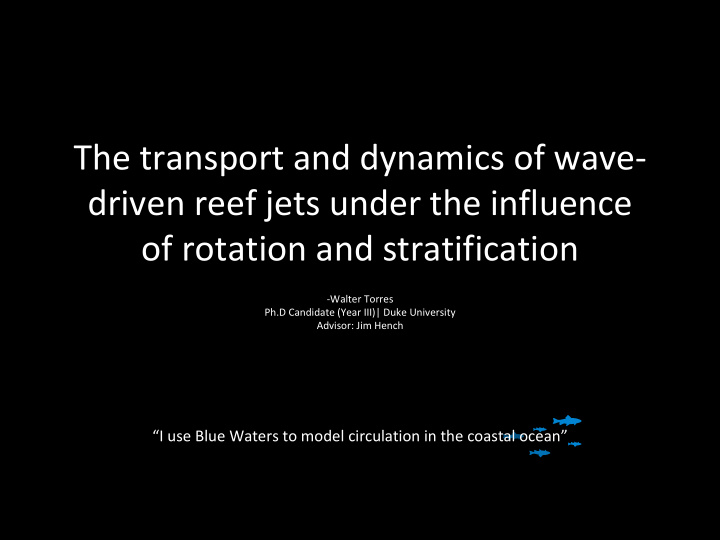



The transport and dynamics of wave- driven reef jets under the influence of rotation and stratification -Walter Torres Ph.D Candidate (Year III)| Duke University Advisor: Jim Hench “I use Blue Waters to model circulation in the coastal ocean”
The transport and dynamics of wave- driven reef jets under the influence of rotation and stratification -Walter Torres Ph.D Candidate (Year III)| Duke University Advisor: Jim Hench
The transport and dynamics of wave- driven reef jets under the influence of rotation and bottom friction -Walter Torres Ph.D Candidate (Year III)| Duke University Advisor: Jim Hench
Gove, J. M. et al. Near-island biological hotspots in barren ocean basins. Nat. Commun. (2016)
Gove, J. M. et al. Near-island biological hotspots in barren ocean basins. Nat. Commun. (2016)
Talley and Co. 1851 General Atlas
Mo’orea, French Polynesia 1 km Talley and Co. 1851 General Atlas
Mo’orea, French Polynesia 1 km
Mo’orea, French Polynesia
Question: What is the effect of rotation and bottom friction on the behavior of wave-driven reef jets? Hypothesis: At given latitude, simulations with higher bottom roughness will experience attenuated waves and currents. This will produce weaker jets that are more affected by the Coriolis force and will deflect more prominently 𝑉 % 𝑔𝑉 = 𝑜𝑝𝑜𝑚𝑗𝑜𝑓𝑏𝑠 𝑀 𝑆𝑝 = 𝑑𝑝𝑠𝑗𝑝𝑚𝑗𝑡 Wave+Current Magnitude Bottom Friction Jet deflection via Coriolis Methods: Idealized coupled wave-circulation numerical modeling (COAWST) - suite of runs varying latitude (Φ) and bottom friction (via z0)
Annulus Domain Grid configuration Height = 1m Period = 10s Wave BC’s Direction = Radial-inward Δ x, Δ y 5m-150m Proposed runs Parameter Values vertical levels 20 Latitude: Φ 0°, N θ , Nr 2048, 256 5°,10°,15°, dt 0.5 s 20°, 25°, 30° Challenges Roughness: z0 0.001, 0.01, -High resolution required resolve fine- (m) 0.1 scale processes = short time step (must satisfy CFL) requires HPC. Thank you Blue Waters!
Annulus Domain
φ = 0°
φ = 45° φ = 45°
φ = 45° φ = 0°
High Friction 0 º Coriolis
Low Friction 0 º Coriolis
High Friction 30 ºS Coriolis
Low Friction 30 ºS Coriolis
Summary • Interaction of eddy shedding from jets, Coriolis, and stokes drift from waves as possible retention mechanism, which is modulated by frictional processes in the back reef Wave+Current Magnitude Bottom Friction Jet deflection via Coriolis Retention? Eddies Stokes drift
Future Work • Longer model integration times to allow for recirculation and eddy interaction with other jets • Preferential sign of vorticity due to centrifugal instability • More model runs to span (z0, φ ) parameter space • Next project: include stratification and diurnal heating forcing for more realistic conditions capturing combined plume+jet dynamics
φ = 45° φ = 0°
“Winterfell”, Game of Thrones S08E01 Dave Hill et al., HBO (2019)
Recommend
More recommend